Get ready to enhance your hand line fishing skills with these 10 expert techniques!
From precision casting to advanced knot tying, each method plays an essential role in improving your catch rate.
Whether you're a beginner looking to level up or a seasoned angler seeking new tricks, these techniques are sure to elevate your fishing game.
Stay tuned to discover how mastering these strategies can make a significant difference in your next fishing adventure.
Key Takeaways
- Master precision casting and control for accurate aim and distance.
- Adjust weight and angle for precise depth control and bait presentation.
- Select appealing live bait and mimic natural movements for effective fishing.
- Utilize drift fishing strategies and knot tying skills for covering large areas and enhancing techniques.
Precision Casting Techniques
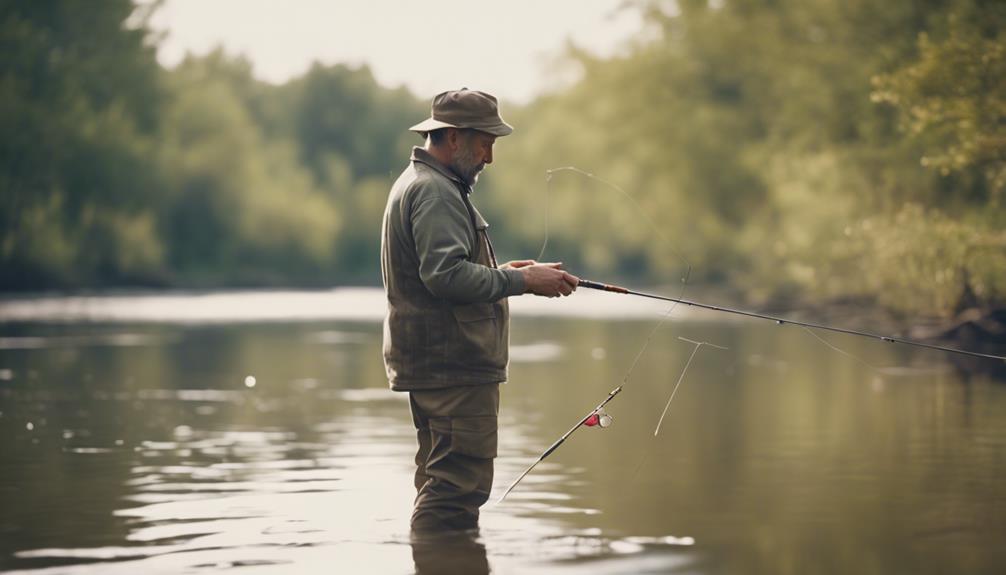
To excel in hand line fishing, mastering precision casting techniques is key. When casting a line, focus on the rod tip to guide your aim. The rod tip acts as your compass, directing the trajectory of your cast towards the intended spot.
By honing your wrist and arm movements, you can control the distance and accuracy of your casts with ease. Timing is critical; make sure you release the line at the precise moment to maximize your accuracy. Understanding how to leverage the weight of the lure and factor in wind direction will further enhance your casting abilities.
Consistent practice is crucial for developing the finesse needed to achieve precise casts in any fishing conditions.
Depth Control Strategies
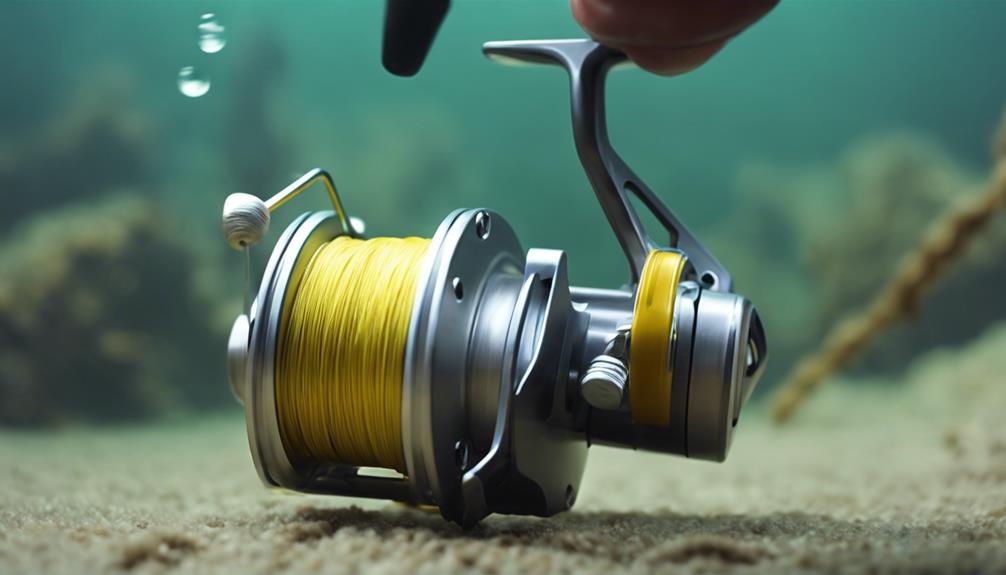
For better control over the depth of your lure in hand line fishing, adjust the weight accordingly. Heavier weights will help you reach deeper depths in the water. To maintain precise depth, keep the line at a 45- to 60-degree angle.
Alter your retrieval speed – slower for deeper presentations and faster for shallower ones. Experiment with various lure types and sizes to match fish behavior. Use markers on the line or time after casting to replicate successful depths.
Bait Presentation Mastery
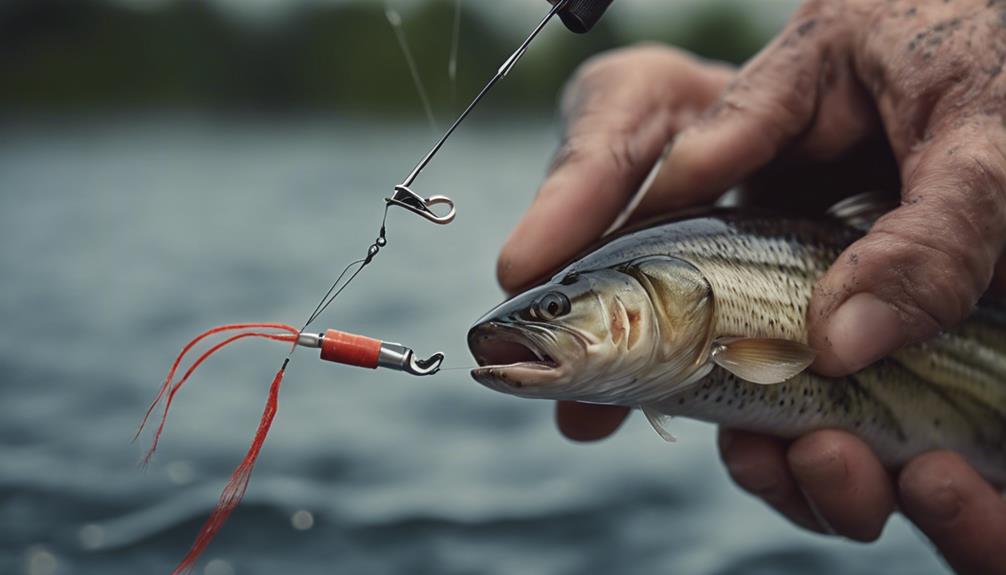
To master bait presentation, focus on where you place your lure. Consider using live bait and try to mimic natural movements. These points will help you attract fish effectively and increase your chances of a successful catch.
Lure Placement Tips
Placing your lure vertically in the water column is key for mastering bait presentation techniques. Using stick baits like the No. 9 Rapala can help you achieve effective lure placement. It's vital to adjust the depth of your lure to match where the fish are in the water.
Experiment with different movements to entice strikes from the fish. Remember, mastering the art of presenting your bait naturally and enticingly is important for attracting fish. By understanding these lure placement tips and fine-tuning your approach, you can increase your chances of a successful catch.
Using Live Bait
When using live bait for fishing, guarantee it's properly hooked to maximize its natural movement and attract more bites from fish. To master the art of live bait presentation, follow these key steps:
- Choose the Right Bait: Select live bait such as minnows, leeches, or nightcrawlers that are appealing to the target fish species.
- Hook Placement: Make sure the hook is securely embedded in the live bait to allow for natural swimming or crawling movements.
- Adjust Depth: Vary the depth of your live bait presentation based on where the fish are located in the water column for better chances of attracting bites.
Mimicking Natural Movements
Maximizing your success in hand line fishing involves mastering the art of mimicking natural movements to effectively attract fish. Understanding how different bait movements imitate live prey can greatly increase your chances of catching fish.
By varying your retrieval speeds and angles, you can replicate natural bait behavior in the water, making your presentation more appealing to target fish species. Adjusting the lure's action to match the current conditions further enhances its attractiveness to the fish you're targeting.
Practice different retrieval techniques with your rod and reel to fine-tune your bait presentation skills. Remember, the key is to make your bait look as natural as possible to entice the fish into striking.
Hook Setting Methods
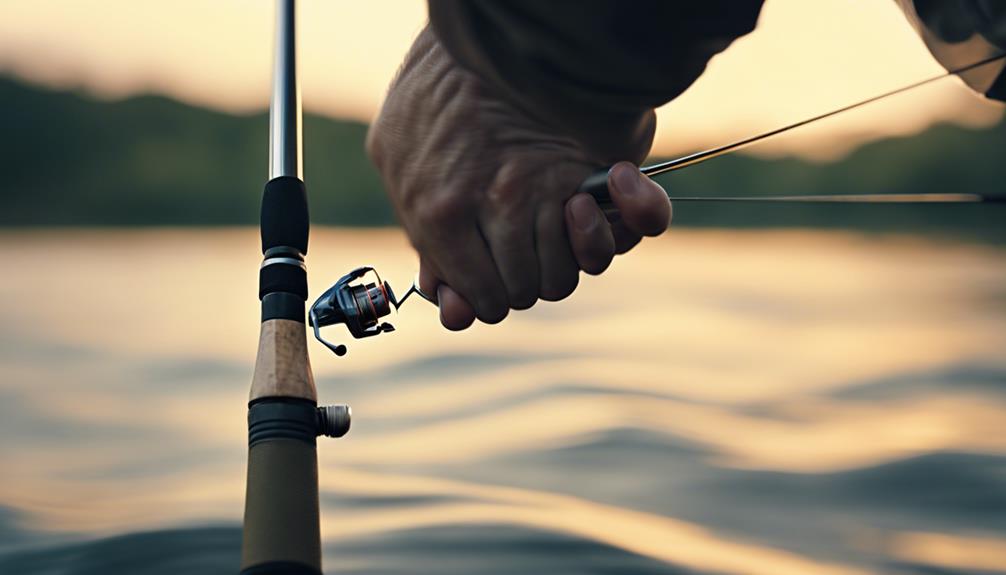
When setting the hook, remember to make a quick upward motion with your rod to secure it properly.
You should also make sure that there's proper tension on the line during the hook set.
Finding the right balance between too hard and too gentle will help you land more fish successfully.
Quick Hook Setting
To guarantee a successful catch while hand line fishing, remember that quick hook setting involves a swift and upward motion of the rod. When setting the hook, make sure you do it promptly to secure the fish before it escapes. Follow these steps for effective hook setting:
- Maintain Tension: Keep tension on the line as you set the hook to prevent the fish from getting away.
- Practice Timing: Work on your timing to swiftly set the hook when you feel a bite.
- Master Technique: Perfect the technique of quickly raising the rod to set the hook firmly.
Proper Line Tension
Guarantee proper line tension for successful hook setting by smoothly reeling in the line to securely set the hook in the fish's mouth. When you feel a bite, resist the urge to yank the line. Instead, reel in steadily to maintain tension.
Keeping the line tight is vital; it prevents the fish from shaking the hook loose during the fight. Jerky movements can make the fish spit out the hook, so aim for a consistent pressure. By keeping the line taut, you increase your chances of a solid hook set.
Line Management Skills

Mastering line management skills is essential for effectively controlling your lure and maximizing your chances of catching fish. To enhance your handlining techniques, focus on the following:
- Maintain Correct Tension: Make sure you maintain the right tension on the line for best lure control.
- Angle Matters: Keep the line at a 45- to 60-degree angle to detect even the most subtle strikes effectively.
- Adjust Depth and Presentation: Effective line management allows you to adjust lure depth and presentation, increasing your chances of enticing more fish.
Fighting and Landing Fish
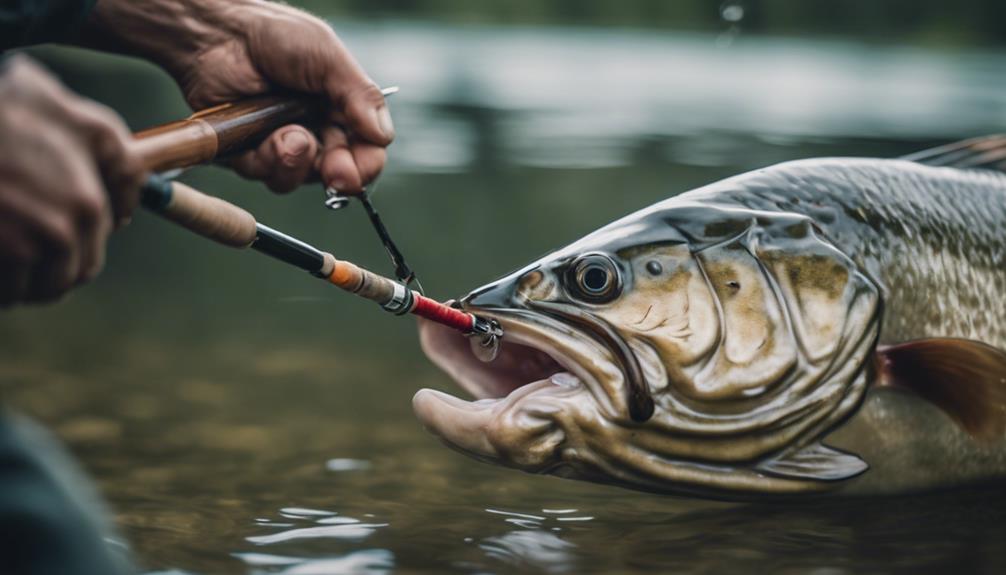
When you're battling a fish, remember to keep steady pressure on it to tire it out.
Use your rod to steer the fish towards you while keeping the line taut.
Stay alert for sudden movements and adjust the reel's drag as needed.
Reeling in the Catch
To successfully reel in a catch while fishing, remember to apply pressure on the fish by lifting the rod and reeling simultaneously to tire it out. Here are some key tips to help you effectively bring in your catch:
- Maintain Tension: Keep the line tight to prevent the fish from escaping during the fight.
- Utilize Rod Flexibility: Let the rod act as a shock absorber to absorb sudden movements and avoid line breakage.
- Lead the Fish: Guide the fish towards the boat by steering it with the rod while ensuring the line stays taut.
Handling the Fight
During the intense battle with a fish, remember to maintain a steady rod angle of 45-60 degrees to effectively control its movements. Keep the pressure on by smoothly pumping the rod and reeling in at the same time. This technique helps tire out the fish and brings it closer to your boat.
Make sure your line stays tight to prevent the fish from shaking the hook loose. Use the flexibility of your rod to absorb any sudden movements the fish makes and avoid breaking the line. Be ready for the fish's bursts of energy; adjust your reeling speed to match its movements.
Securing the Landing
As you reel in the exhausted fish, keep the rod tip up and maintain tension on the line to guide it towards your boat or shore securely.
To secure the landing, follow these steps:
- Apply consistent pressure on the fish to tire it out and prevent it from escaping.
- Keep the rod tip up and maintain tension on the line to control the fish's movements.
- Use the rod to guide the fish towards the boat or shore while keeping the line tight.
Live Bait Handling

When handling live bait for hand line fishing, make sure it stays lively and enticing to attract big fish effectively. Use spinning reels for better control over bait presentation.
Properly hook the live bait to maintain its natural movement, increasing its appeal to the target fish. To keep the bait fresh and lively, change it regularly to maximize its effectiveness.
Adjust the depth of the live bait presentation according to fish behavior and feeding patterns. Remember, live bait handling demands finesse and attention to detail to entice bites from various fish species.
Mastering the art of live bait handling can greatly improve your hand line fishing success.
Artificial Lure Manipulation
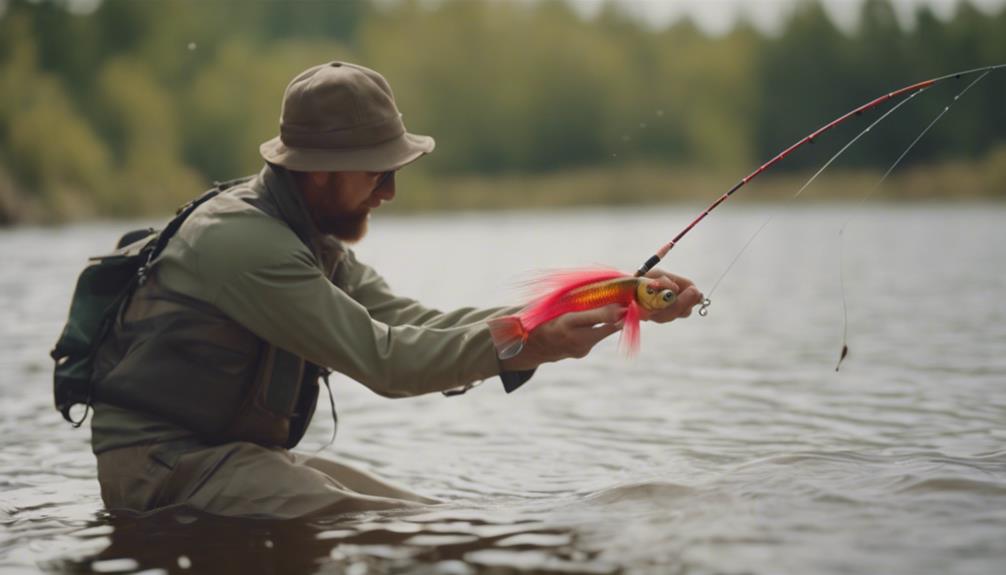
To master artificial lure manipulation in hand line fishing, focus on giving the lures a starting-and-stopping action to attract fish effectively. When manipulating artificial lures, remember these key techniques:
- Vary Speed and Movement: Change the speed and movement of the lure to imitate live bait and trigger strikes.
- Control Depth and Direction: Use handlining techniques to control the depth and direction of the artificial lure in the water.
- Experiment with Retrieval: Try different retrieval speeds and pauses to entice fish to bite the artificial lure.
Drift Fishing Tactics
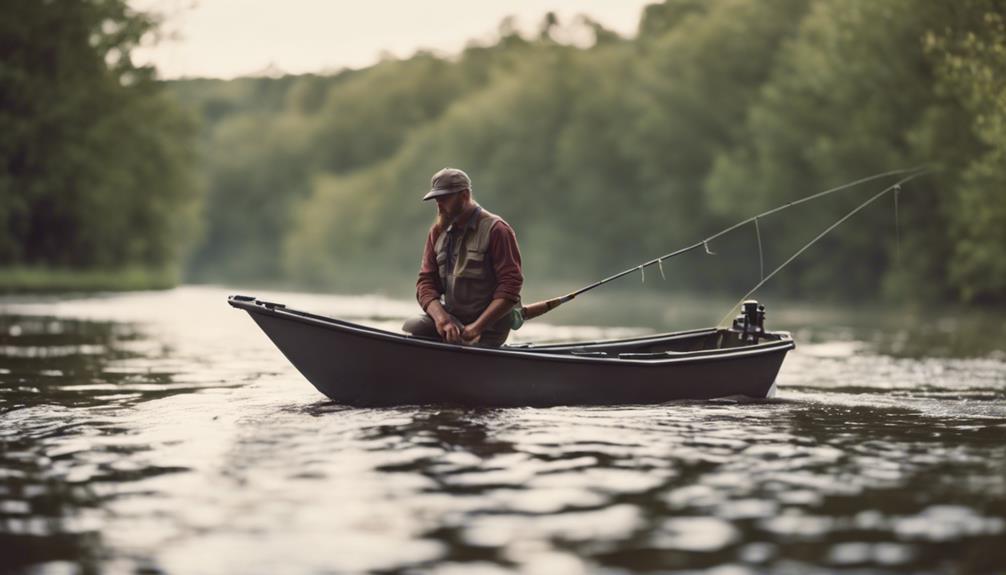
Drift fishing involves letting your hand line lure naturally drift with the current to entice fish. To succeed, it's essential to control the drift speed, ensuring your lure stays in the strike zone.
You can adjust the weight of the lure or use a dropper rig to manage the drift in varying currents. This technique is great for covering large areas and presenting your lure naturally to fish.
Pay close attention to the drift speed and direction; these factors greatly impact your chances of a successful catch. By mastering drift fishing tactics and understanding how the weight of the fish affects your approach, you'll increase your chances of reeling in a big one.
Advanced Knot Tying Skills
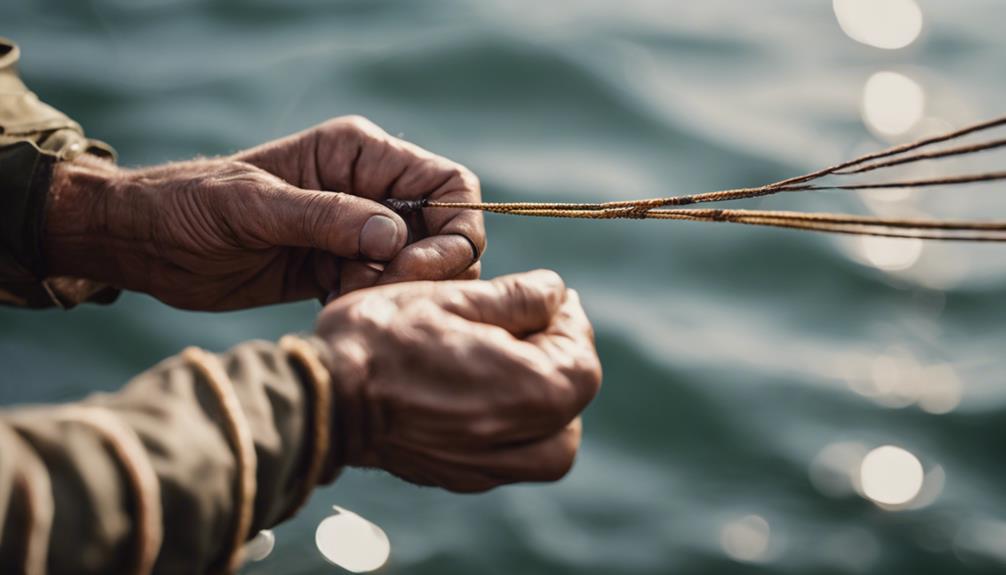
Enhance your fishing skills by mastering advanced knot tying techniques for secure and reliable connections.
- Learn the Palomar knot, Clinch knot, and Improved Clinch knot for strong connections.
- Prevent line breakage and guarantee successful catches by using reliable knots.
- Practice different knot tying techniques to quickly secure your bait or lure while fishing.
Conclusion
So there you have it – 10 expert hand line fishing techniques that can help you reel in the big one!
Remember to practice, stay patient, and have confidence in your abilities.
Whether you're slipping the current or mastering artificial lure manipulation, these tips can help you become a successful handliner.
So grab your gear, head out to the water, and give these techniques a try.
Happy fishing!
👨👩👧👦 Dwight’s a married dad of 4 who loves to cast a line 🎣 into both fresh and salt waters. His heart belongs to his family and the sea. 🌊 #FamilyMan #FishingLife #DadOf4 🐟✨

